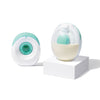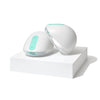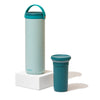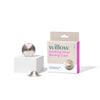If you’ve been on medication or drank alcohol while nursing, you may have wondered if you ought to pump it and dump it. The answers may surprise you.
Pumping and dumping is a common expression used to describe pumping breast milk you assume isn’t safe for your baby, then discarding it. The thought of doing that might stress you out. But as pediatrician Dr. Laurie Jones, founder of Dr. MILK (Mothers Interested in Lactation Knowledge), explains, “You almost never need to pump and dump.”
Q: Why do some people think that they have to pump and dump?
A: The most common reasons include medication, surgery/anesthesia, dental procedures, and alcohol consumption. It’s one of the top reasons why moms stop breastfeeding; they’re told to do it if they’re on medications, or there are other perceived breastfeeding contraindications. Most of the time, they don’t actually have to.
Q: Should you pump and dump after drinking alcohol?
A: After a year of sobriety in pregnancy, you are likely a lightweight—a small amount of alcohol can make you feel tipsy. Here’s the rule of thumb: If you can hold and take care of your baby, you can breastfeed or feed your baby freshly pumped milk. If you are so inebriated that you can’t do either, then you shouldn’t feed your baby at all. But if you feel the need to pump to maintain your supply (or relieve engorgement), go ahead and do so.
Q: If you drink too much, should you throw away the milk?
A: No! If you’re too drunk to drive or to serve the milk, don’t toss it. Freeze, label it as “toddler milk,” and save for after your little one is a year old. You can dilute it with other pumped milk and feed it to your baby that way, or mix it with solids.
Q: Is there anything you can do to prepare for a night out?
A: If you know you are going out to dinner and you want to drink, have a few sips before you leave the house, while you are nursing—it won’t immediately go into your milk. And then? Hydrate! Alcohol impacts your milk volume because it’s dehydrating, and how quickly you metabolize it will vary.
Q: What about marijuana or CBD?
A: Marijuana will stay in a baby’s system for two to three weeks after maternal marijuana use. It can cause neurodevelopmental harm to the infant and is a clear no during pregnancy and lactation periods. The Food and Drug Administration advises against using marijuana and any products containing cannabidiol while breastfeeding altogether.
Q: What about surgery and anesthesia?
A: It’s common to delay surgeries such as gallbladder removal until after your baby is delivered. In the case of surgery, follow the same rule of thumb for alcohol: If you can hold and nurse your baby, you can directly breastfeed or feed your baby freshly pumped milk. If you’re still too out of it for any reason after having anesthesia, pump, label it “toddler milk,” and freeze it to combine with other milk or solids for future use.
Q: What about prescription painkillers you might receive after surgery, such as a C-section or dental procedure?
A: The same rule applies: If you can hold your baby safely, you can breastfeed your baby. But breastfeeding mothers should not be given hydrocodone (i.e. acetaminophen with codeine) or tramadol (an opioid). Even if you metabolize it rapidly, your baby might not. It’s not worth the risk.
Q: What about an MRI, mammogram, or CT scan?
A: After administering diagnostic breast-imaging procedures such as an MRI, mammogram, or ultrasound, doctors previously advised breastfeeding women to pump and dump. However, all three are safe during lactation, and do not require cessation of breastfeeding. That said, it’s smart to directly breastfeed your baby or pump shortly before a mammogram, to improve the sensitivity of the test.
Q: What about sleep aids?
A: Anything taken for maternal sleep that actually makes you sleep means you shouldn't be feeding or pumping at night. But if you feel the need to pump, go ahead, label it “toddler milk,” and save it for when your baby is a year or older to dilute or accompany solids.
Q: What about medications for postpartum anxiety or depression?
A: If you take a once-daily antidepressant prescription, no pumping and dumping is needed. But if you take a medication such as a benzodiazepine (i.e., Xanax or klonopin) that makes you so drowsy you can’t drive or care for your child, save it, and label it “toddler milk.” Ask another caregiver to give your baby a bottle.
Q: Are there any other medications or drugs that are absolutely incompatible with breastfeeding and pumping?
A: Yes, IV chemotherapy drugs and radioactive iodine are two things that should not be combined with breastfeeding.
Q: Can you recommend other resources?
A: The Institute for the Advancement of Breastfeeding and Lactation Education aims to educate and help demystify a lot of the pumping-and-dumping conversation. Infant Risk is well regarded, as is the MommyMeds app. This article contains a great infographic about medications and breastfeeding.
Q: What do you advise traveling moms to do with their milk?
A: If you are far away from your baby for several days, and you don’t want to send your milk home with a service such as MilkStork but want to maintain your supply, don’t sweat it. You can dump it without an ounce of guilt. The important thing is to keep your supply up when you are away from your baby, and pumping will help you do that.
Q: Any final words of advice?
A: When it comes to health care recommendations, it’s not unusual for medical personnel to default to the guidance for pregnancy and use that for breastfeeding because they are not trained in lactation protocols. But the placenta and the breast are not the same organ; the guidance isn’t always the same. If you’re being told to pump and dump, ask why.
Follow us @willowpump on Instagram, visit our blog and subscribe to our YouTube channel for more tips and expert-backed guidance.
Tags Used





